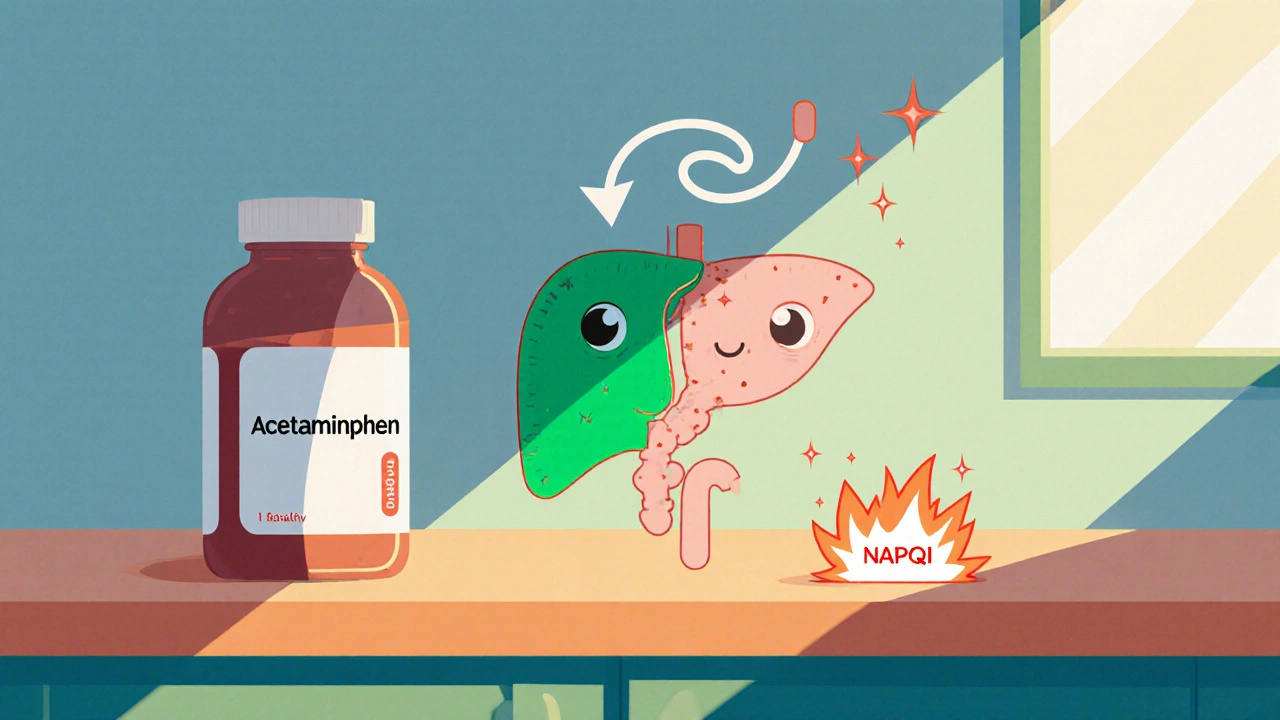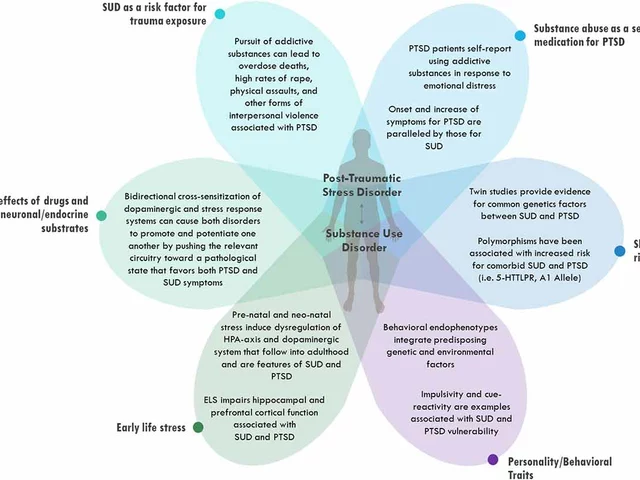Acetaminophen Liver Cancer Risk Calculator
Risk Assessment Tool
This tool estimates relative risk based on the article's findings about chronic acetaminophen use and liver cancer risk.
Results will appear here
People wonder whether the everyday painkiller acetaminophen is a widely used analgesic and antipyretic might raise the odds of developing liver cancer. The short answer is: the evidence isn’t crystal‑clear, but several clues point to a possible connection at high or chronic doses. This guide walks through how acetaminophen harms liver cells, what the latest epidemiological studies have found, and how you can keep the risk as low as possible.
How Acetaminophen Affects the Liver
When you take a normal dose, most acetaminophen is safely processed by the liver’s Phase II pathways (glucuronidation and sulfation). A tiny fraction, however, is turned into a reactive metabolite called N‑acetyl‑p‑benzoquinone imine (NAPQI). In a healthy liver, glutathione (GSH) quickly neutralises NAPQI. If you overload the system-by taking too much at once or using the drug daily for months-glutathione stores can run low, leaving NAPQI to bind to cellular proteins and trigger oxidative stress.
This chain reaction can cause hepatocellular injury, ranging from mild enzyme elevation (ALT, AST) to acute liver failure. Chronic low‑grade injury is what researchers suspect might set the stage for malignant transformation, especially when other risk factors (alcohol, viral hepatitis, cirrhosis) are present.
Evidence From Epidemiological Studies
Large‑scale cohort and case‑control studies from the US, UK, and Asia have tried to tease out the link. A 2022 meta‑analysis of five prospective cohorts (over 1.2 million participants) reported a modest 1.3‑fold increase in hepatocellular carcinoma (HCC) risk among people who reported taking >2 g of acetaminophen per day for more than five years, compared with non‑users. The same meta‑analysis found no significant rise for occasional users (<1 g/day).
In contrast, a 2023 case‑control study from Taiwan, which adjusted for hepatitis B infection and alcohol, found no independent association after controlling for total cumulative dose. Researchers noted that under‑reporting of over‑the‑counter use probably diluted the signal. These mixed results highlight why the link remains “potential” rather than definitive.
Dose‑Response Findings
| Average Daily Dose | Approx. mg/kg (70 kg adult) | Relative Risk (HCC) |
|---|---|---|
| Less than 10 g | <10 mg/kg | 1.0 (baseline) |
| 10-15 g | 10-15 mg/kg | 1.2-1.4 (slight increase) |
| More than 15 g | >15 mg/kg | 1.8-2.3 (moderate increase) |
These figures come from pooled analyses and should be read as trends, not guarantees. Even at the highest tier, the absolute increase in cancer cases remains small-roughly 2‑3 extra cases per 10,000 long‑term users.
Other Risk Factors That Interact
Acetaminophen doesn’t act in a vacuum. Heavy alcohol consumption depletes glutathione, magnifying NAPQI toxicity. Chronic viral hepatitis (B or C) already inflames liver tissue, making it more vulnerable to additional oxidative hits. Non‑alcoholic fatty liver disease (NAFLD) and cirrhosis likewise create a pro‑carcinogenic environment. When these co‑morbidities coexist, the combined risk can be higher than the sum of its parts.
Genetic variations in the CYP2E1 enzyme, which helps generate NAPQI, also influence individual susceptibility. Some populations-particularly East Asians-carry alleles that produce more NAPQI, potentially explaining regional differences in study outcomes.
Clinical Recommendations for Consumers
- Stick to the label: no more than 4 g (8 standard 500 mg tablets) in 24 hours for adults.
- If you need pain relief for more than a few days, rotate with non‑acetaminophen options (ibuprofen, naproxen) where appropriate.
- People with liver disease, chronic alcohol use, or viral hepatitis should discuss any regular acetaminophen use with their doctor.
- Watch for hidden acetaminophen in combination products (cough syrups, cold packs). The total daily dose counts across all sources.
- Seek medical attention if you notice persistent nausea, dark urine, or yellowing of the skin-early signs of liver injury.
These practical steps keep the acetaminophen liver cancer link risk at the lowest possible level while still allowing the drug’s benefits.
Ongoing Research & Gaps
The FDA and WHO have funded prospective registries that track long‑term acetaminophen users, aiming to capture precise dosage data and liver outcomes. New biomarkers-like serum microRNA‑122-could detect sub‑clinical liver injury before enzymes rise. Meanwhile, animal studies are probing whether low‑dose chronic exposure leads to DNA adduct formation, a potential early step toward cancer.
What we still lack:
- Randomised controlled trials that ethically test high‑dose chronic use (so we rely on observational data).
- Standardised measurement of over‑the‑counter consumption.
- Clear guidance on safe limits for people with pre‑existing liver conditions.
Until those gaps close, the safest approach is moderation and vigilance.
Quick Checklist - Assess Your Personal Risk
- Do you consume more than 4 g of acetaminophen per day? - Yes/No
- Do you have chronic liver disease, viral hepatitis, or heavy alcohol use? - Yes/No
- Are you using multiple acetaminophen‑containing products simultaneously? - Yes/No
- Do you experience unexplained fatigue, abdominal pain, or jaundice? - Yes/No
If you answered “yes” to any of the above, talk to a healthcare professional about alternative pain‑relief strategies.
Frequently Asked Questions
Can occasional use of acetaminophen cause liver cancer?
Most studies show that occasional or short‑term use (under 1 g per day) does not increase liver cancer risk. The concern arises mainly with chronic high‑dose use.
Is the risk the same for adults and children?
Children metabolise acetaminophen differently and are usually given lower weight‑based doses. Reported cases of liver cancer linked to acetaminophen in children are extremely rare.
How does alcohol interact with acetaminophen?
Alcohol depletes glutathione, the molecule that neutralises the toxic NAPQI metabolite. Heavy drinkers who also take high doses of acetaminophen have a higher chance of liver injury, which can contribute to cancer risk over time.
Should I avoid acetaminophen if I have hepatitis B?
Patients with chronic hepatitis B or C should limit acetaminophen to the lowest effective dose and avoid exceeding 2 g per day unless a physician advises otherwise.
Are there any safer alternatives for chronic pain?
Non‑steroidal anti‑inflammatory drugs (NSAIDs) like ibuprofen can be alternatives, but they carry their own GI and renal risks. Physical therapy, topical agents, and lifestyle changes are also worth discussing with a clinician.





October 18, 2025 AT 12:50 PM
Yo, the pharmas are hiding the truth about acetaminophen! Every over‑the‑counter pill has secret additives that can mess w/ your liver if you take ’em daily. They don’t want you freaking out, so they keep the warnings buried deep. Stay woke and read the fine print, fam.
October 26, 2025 AT 01:24 AM
I’ve read the same studies and, in simple terms, high‑dose acetaminophen over many years may slightly raise liver cancer risk. The evidence isn’t crystal clear, but it’s wise to keep doses low, especially if you have other liver stressors.
November 2, 2025 AT 12:57 PM
Sounds reasonable. Use it sparingly and watch your liver enzymes.
November 10, 2025 AT 01:30 AM
While the meta‑analysis does indicate a modest 1.3‑fold increase, the confidence intervals overlap with unity; thus, the statistical significance is tenuous, and confounding factors such as alcohol intake or viral hepatitis must be rigorously controlled for, otherwise the association may be spurious.
November 17, 2025 AT 14:04 PM
Hmm… life is short, painkillers are cheap, but maybe think twice before you pop them every day :)
November 25, 2025 AT 02:37 AM
Seriously? People act like a little extra acetaminophen is nothing. It’s a chemical time‑bomb for the liver, and anyone who dismisses the data is just ignoring the sheer drama of cellular death, huh? Wake up!
December 2, 2025 AT 15:10 PM
Obvi, the pharmacokinetic pathways are a labyrinthine symphony of conjugation and detox. If you oversaturate the glutathione reserves, NAPQI waltzes in like a rogue virtuoso, causing oxidative havoc. That’s why chronic high‑dose usage is not a trivial footnote, it’s a full‑blown saga of hepatic rebellion.
December 3, 2025 AT 05:04 AM
Exactly! Let’s keep the conversation upbeat – moderation is the hero here. If you stick to recommended doses, you’re lining up on the right side of the story, turning potential chaos into calm.
December 3, 2025 AT 13:24 PM
Wow, thanks for the groundbreaking insight.
December 10, 2025 AT 12:04 PM
When one contemplates the intricate tapestry of hepatic metabolism, one must first acknowledge the elegant orchestration of Phase II conjugation pathways – glucuronidation and sulfation – which, in their routine capacity, shepherd the majority of acetaminophen molecules toward benign excretion. Yet, lurking beneath this steady rhythm lies the cryptic formation of N‑acetyl‑p‑benzoquinone imine, a metabolite whose very existence hinges upon a delicate balance of enzymatic flux. In a liver endowed with ample glutathione reserves, this electrophilic specter is swiftly neutralized, its potential for covalent binding quelled in the blink of a cellular eye. However, should the glutathione reservoir dwindle, whether by sustained high‑dose exposure, concomitant alcohol metabolism, or underlying hepatic pathology, the once‑harmless NAPQI transforms into a harbinger of oxidative distress.
Oxidative stress, in turn, initiates a cascade of lipid peroxidation, protein adduct formation, and mitochondrial dysfunction – all hallmarks of hepatocellular injury. The chronic low‑grade injury that may ensue is not merely a biochemical footnote; it represents a fertile ground upon which neoplastic transformation can take root, particularly in the context of synergistic risk factors such as chronic viral hepatitis or cirrhosis.
The epidemiological literature, while not unequivocal, does suggest a modest elevation in hepatocellular carcinoma incidence among cohorts consuming greater than two grams of acetaminophen daily for extended periods. The meta‑analytical hazard ratio of 1.3, though modest, cannot be dismissed outright, especially when the confidence intervals approach unity and the potential for residual confounding looms large.
From a pragmatic standpoint, the prudent individual should therefore heed the principle of “as low as reasonably achievable.” This entails adhering to recommended dosing intervals, avoiding concomitant use of other hepatotoxic agents, and maintaining vigilance regarding liver function tests when chronic use is unavoidable. In doing so, one navigates the fine line between therapeutic benefit and inadvertent harm, honoring both the chemical elegance of the drug and the fragile resilience of the organ tasked with its disposition.